 Mathematical "P" Words
Mathematical "P" Words
*Dictionary
Alert
palindrome
A number or word that reads the same
way from right to left as it does left to right.
EX:
- BOB
- 121
- A MAN A PLAN A CANAL PANAMA
- ABLE WAS I ERE I SAW ELBA
parabola
The conic section formed by a plane parallel to an edge of the conical
surface.
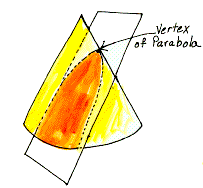
paragraph proof A form of written proof in which conclusions and justifications are combined in sentences and put into paragraph form.
parallel
lines
Two lines in a plane are parallel if they have no points in common or
are identical.
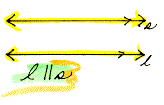
NOTE: two common symbols used to indicate parallel lines are the extra arrowheads placed on the lines as you see in the example above and also the || symbol.
parallelogram
A quadrilateral
with two pairs of parallel sides.

Parallel
planes
Planes which have no points in common or are identical.
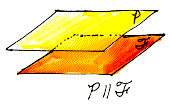
parentheses ( ) Grouping symbols which indicate the order of operations that should be followed in evaluating an expression; the work inside them should be done first.
pattern A general form for which there are many examples.
pentagon
A five-sided
polygon.

percent
% means times
1/100 or .01, one one-hundredth.
Ex: 7% = 7 times (1/100) = 7/100 or 0.07.
NOTE: Many people are not aware of how the idea of percents got started. If you know this bit of math history, it may help you remember how to use percent properly.
Back in the Middle Ages most people were uneducated and illiterate. The only people who could read, write and do math were the priests. In an attempt to keep people ignorant of money matters, the priests told the people that numbers were evil. If they were to speak a number or try to write it, the devil would enter their souls.
Now this sounds crazy to us, but the common, uneducated, serfs of the day believed it strongly. In fact, they believed it so much that when a peddler would come to town trying to sell goods for a given number of gold pieces, the townspeople would run him out of town, as though he were the devil himself.
Well as you can imagine, this made it hard to be a small businessman in the Middle Ages. To conquer this problem, the peddlers got together and decided to fight superstition with superstition. They invented a symbol which would "cast the evil out" of any number. This symbol was the percent symbol. So if you were selling a chicken and you wanted to say, "That will be 85 cents please," you would have to say , "That will be 85 percent." Or you could write % which would also cast out the devil from written numbers.
Basically in our number system, the word percent means "penny". So 15% is 15 pennies or 0.15. 200% would be 200 pennies or 2 full dollars.
It is amazing how even though percents are not really needed today, they are so embedded in our culture that you see them everywhere money is being exchanged: stores, banks, investments, etc..
perimeter The sum of the lengths of the sides of a polygon.... or the length of the boundary of a closed region.
perimeter of a polygon The sum of the lengths of its sides.
perimeter
of a rectangle
2l + 2w where l is the length
and w is the width of a rectangle.

permutation
an ordered arrangement of a set of objects.
ex: if there are three books X, Y, and Z they can be arranged on
a shelf in six different ways (permutations)
XYZ
XZY
YXZ
YZX
ZXY
ZYX
perpendicular
The name
given to rays, segments, or lines that form right angles.
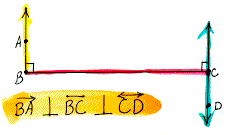
perpendicular
bisector method
A method for finding the center of a circle that involves drawing perpendicular
bisectors of two chords. You can use this method to perform the really
cool trick of drawing a circle through any three non-colinear points.
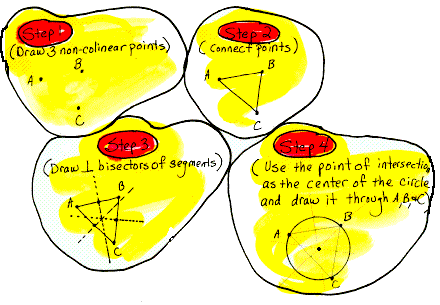
perpendicular bisector of a segment In a plane, the line containing the midpoint of the segment and perpendicular to the segment.
perpendicular
planes
Planes whose dihedral angle is a right angle.
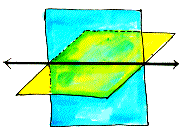
perspective
drawing
A drawing of a figure made to look as it would in the real world. To achieve
this illusion receding parallel lines are drawn to converge at a point
on the horizon called the vanishing point.
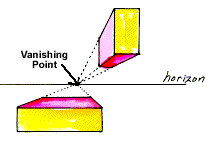
pi
![]() Every circle,
big or small, has a special relationship between its circumference
and its diameter. If you divide the circumference by the diameter you
always get the same number!
Every circle,
big or small, has a special relationship between its circumference
and its diameter. If you divide the circumference by the diameter you
always get the same number!
C/D is always approximately 3.1415926535 ... .
Pi is an irrational number.
That means that it is a decimal that never repeats or terminates. It CAN
NOT be written as a fraction exactly. The Greeks who first found this
relationship used the Greek letter ![]() to stand for the decimal and we are still using it today.
to stand for the decimal and we are still using it today.
pie
graph A
graph in which information is represented using a circle that has been
cut into sectors to show values of a particular category. Also called
circle graph.
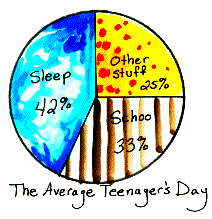
pint A unit of capacity in the U.S system of measurements equal to two cups, or 1/2 a quart, or 16 ounces, or 0.473 liters.
pixel A dot on a TV or computer screen or other monitor.
place
value
The numbers that each digit stands for in a decimal.
In the illustration below, if you think of the one's place and the decimal
point as the center, the names correspond on either side. Remember, the
numbers to the right of the decimal point always end in "ths".
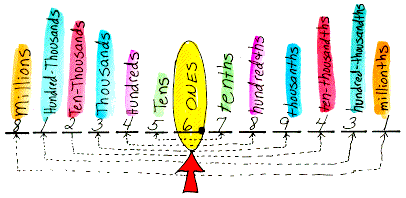
plane An undefined geometric term. In Euclidean Geometry, a plane is understood to be a flat surface that extends infinitely in all directions..
plane coordinate geometry The study of points as ordered pairs of numbers.
plane figure A set of points that are all in one plane.
plane geometry The study of figures which lie in the same plane.
plane section The intersection of a three-dimensional figure with a plane.
point An undefined geometric term. In Euclidean Geometry, a point can be thought of as a dot that represents a location on a plane or in space. These points have no size.
point of
tangency The
point at which a tangent intersects the curve (circle) or curved surface
(sphere).
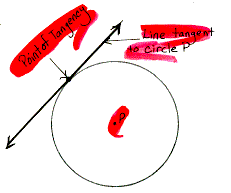
polygon
A union of three or more coplanar
segments (its sides) such that each segment intersects exactly two others,
one at each of its endpoints (its vertices).

polygonal region The union of a polygon and its interior.
polyhedron
A three-dimensional surface which is the union of polygonal regions (its
faces) and which has no holes. Plural: polyhedra.
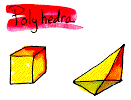
polynomial A monomial or a sum of any number of monomials. An expression that is the sum or difference of two or more terms.
EX: 3x + 4xy - 7
positive integer Any one of the numbers 1, 2, 3, ... . Also called natural numbers. Remember that 0 is neither positive nor is it negative.
postulate A statement assumed to be true. Also called axiom.
pound
(lb.)
A unit of weight in the U.S. system of measurement equal to 16 ounces.
1 pound![]() 0.4536
kilograms.
0.4536
kilograms.
power
The answer to a problem ![]() .
In this power, "a" is called the base and "b" is called
the exponent.
.
In this power, "a" is called the base and "b" is called
the exponent.
ppm
Parts per million. This unit is frequently used
in reporting the concentration of pollutants in water and air. It means
that in a mixture, there is 1 part by mass of the subject material in
1 million parts of the mixture. Thus in water, 1 PPM corresponds to 1
g of pollutant per million g of water,
(or, more accurately, of solution). By shifting the decimal point, you
can see that this is equal to 0.001 g per 1000 g, or 1 mg/kg. Because
1 L of water weighs 1 kg, 1 PPM also corresponds to 1 mg/L.
preimage The original figure in a transformation.
preimage point A point to which a transformation has been applied.
preserved property Under a transformation, a property which, if present in a preimage, is present in the image.
prime number A positive integer whose only positive integer divisors are itself and one.
NOTE: One is not considered prime because it has only one positive integer divisor, itself. Two is the first prime number and it is the only even prime.
prism
To create a prism, start with a polygon base, then translate this base
to a parallel plane, then connect the corresponding vertices of the two
bases.
probability A number from 0 to 1 which indicates how likely something is to happen. A probability of 0 means the event cannot happen. A probability of 1 means it will definitely happen. A probability of 0.5 means you have a 50% chance of it happening.
product The resulting of doing a multiplication.
Product of Reciprocals Property For any nonzero number n: n times 1/n = 1.
proof A sequence of justified conclusions, leading from what is given or known to a final conclusion.
Property of Opposites For any number n: n + -n = 0. Opposites always add to zero.
proportion
A statement
that two fractions (ratios) are equal.
 |
NOTE: In a proportion the product of the numbers on the diagonals will be equal. Some folks say the "cross products" are equal and some say the product of the "means" equals the product of the "extremes". |
proportional numbers Four numbers that form a true proportion.
proportional thinking The ability to get or estimate an answer to a proportion without going through the equation-solving process.
protractor A instrument used for measuring angles. Click the word to get some disposable protractors.
pyramid
A polyhedron in which all but one of the polygonal faces intersect at
a single point known as the vertex of the pyramid. The side which
does not intersect at the vertex is called the "base".

Pythagorean
theorem
In a right triangle with legs a and b, and hypotenuse.

Pythagorean triple A set of three numbers that can be the lengths of the sides of a right triangle.
EX: 3, 4, & 5 make a Pythagorean triple because
Home | About
Us | Algebra| Dictionary | Games | Geometry | Gym | Humor | Lab | Magic | Natural Math | PreAlgebra | Resources | Teachers Only | Toolbox | Treasures | Videos | Wonders | Writings |
Copyright © 1999-2020 themathlab.com

